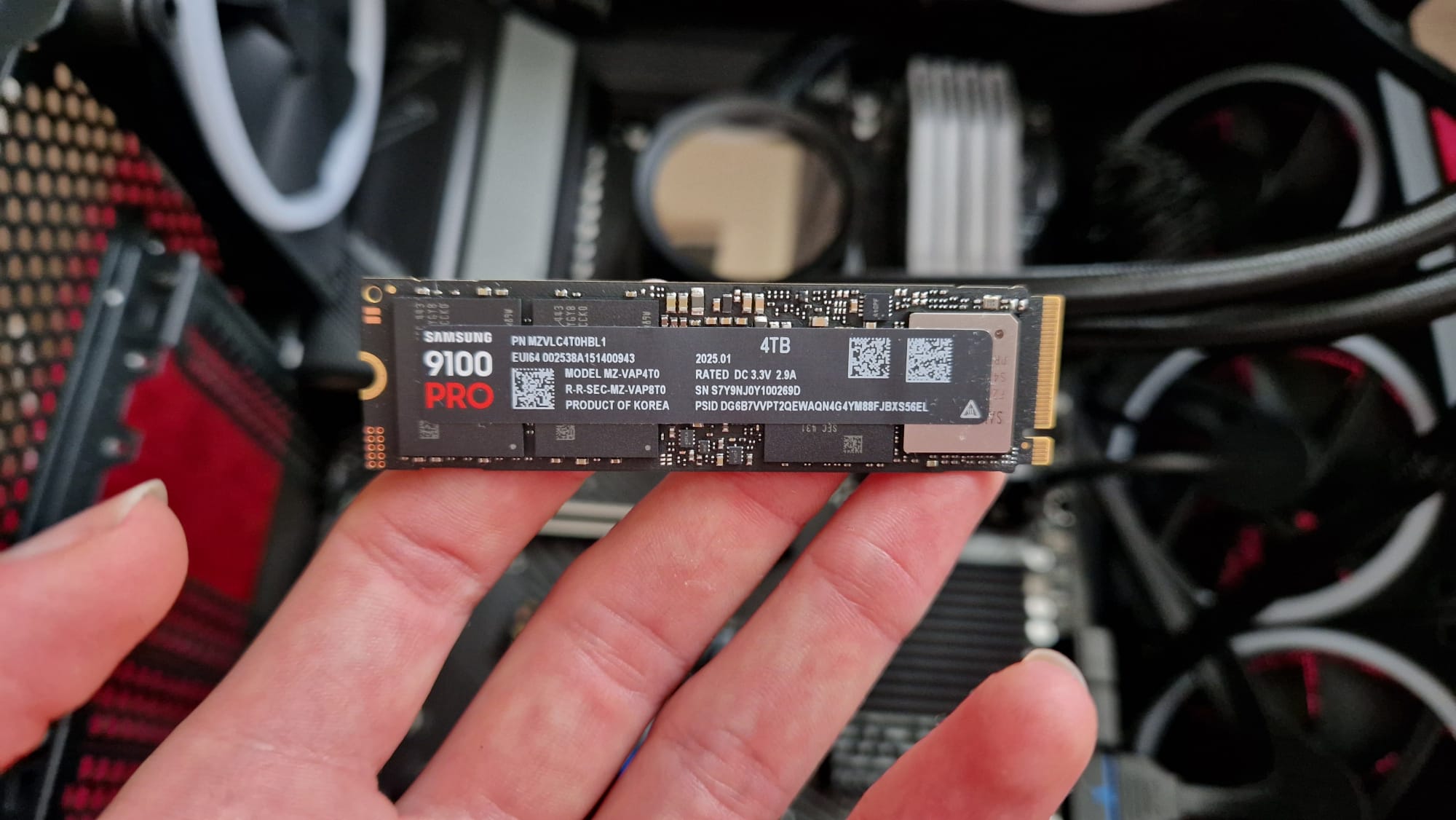GamesRadar+ Verdict
It hurts to say this, because the Samsung 9100 Pro is quite literally one of the fastest SSDs ever made, but it’s still as tricky to recommend as any other Gen 5 device. Video game support for these mega-fast Gen 5 SSDs still isn’t widely adopted, and that doesn’t look like it’ll change anytime soon. When it costs significantly more than Gen 4 drives that already provide excellent speeds, that’s a tough sell. That said, the storage nerd in me can’t get over the stupidly impressive read and write speeds this thing is capable of.
Pros
- +
Ludicrous speeds
- +
Faster than other Gen 5 options
- +
Great loading times and transfer rates
- +
Futureproofing
- +
Temperature control despite said speeds
Cons
- -
Gen 5 support is still few and far between
- -
Pricey
- -
Gaming performance on Gen 4 drives still isn’t too far behind
Why you can trust GamesRadar+
The Samsung 9100 Pro has shown up late to the party, but it seems like it’s done so on purpose. It’s that guest who wants to be seen making an entrance, and that’s fair enough, because Samsung makes some great storage devices. As someone who’s been reviewing SSDs for more than two years, I’ve seen new, flashy, super-speedy Gen 5 drives launch from all sorts of manufacturers. Adata, Crucial, T-Force, PNY, and even Acer have been in the market for a while now, but the biggest gaming brands like Samsung and WD are only just joining the battle.
And yet, as late as the 9100 Pro is in arriving, it still feels premature. It’s so silly that even in 2025, I still hesitate to call them the best SSDs for gaming, simply because their practical uses don’t live up to their sky-high prices. And at the same time, it’s impossible to deny that devices like the 9100 Pro are feats of engineering. Samsung’s new flagship doubles what the standard SSD speed has been for the last five or six years now.
That sounds impressive on paper, but arguably, we’ve reached a point with loading times where returns are starting to diminish. These SSDs are always way more expensive than their Gen 4 counterparts, with the Samsung 9100 Pro’s 1TB model alone wearing a $199 / £171 price tag at the time of writing. When that equates to about 5 seconds more spent in a loading screen, is it going to be worth the extra money?
Design & Availability
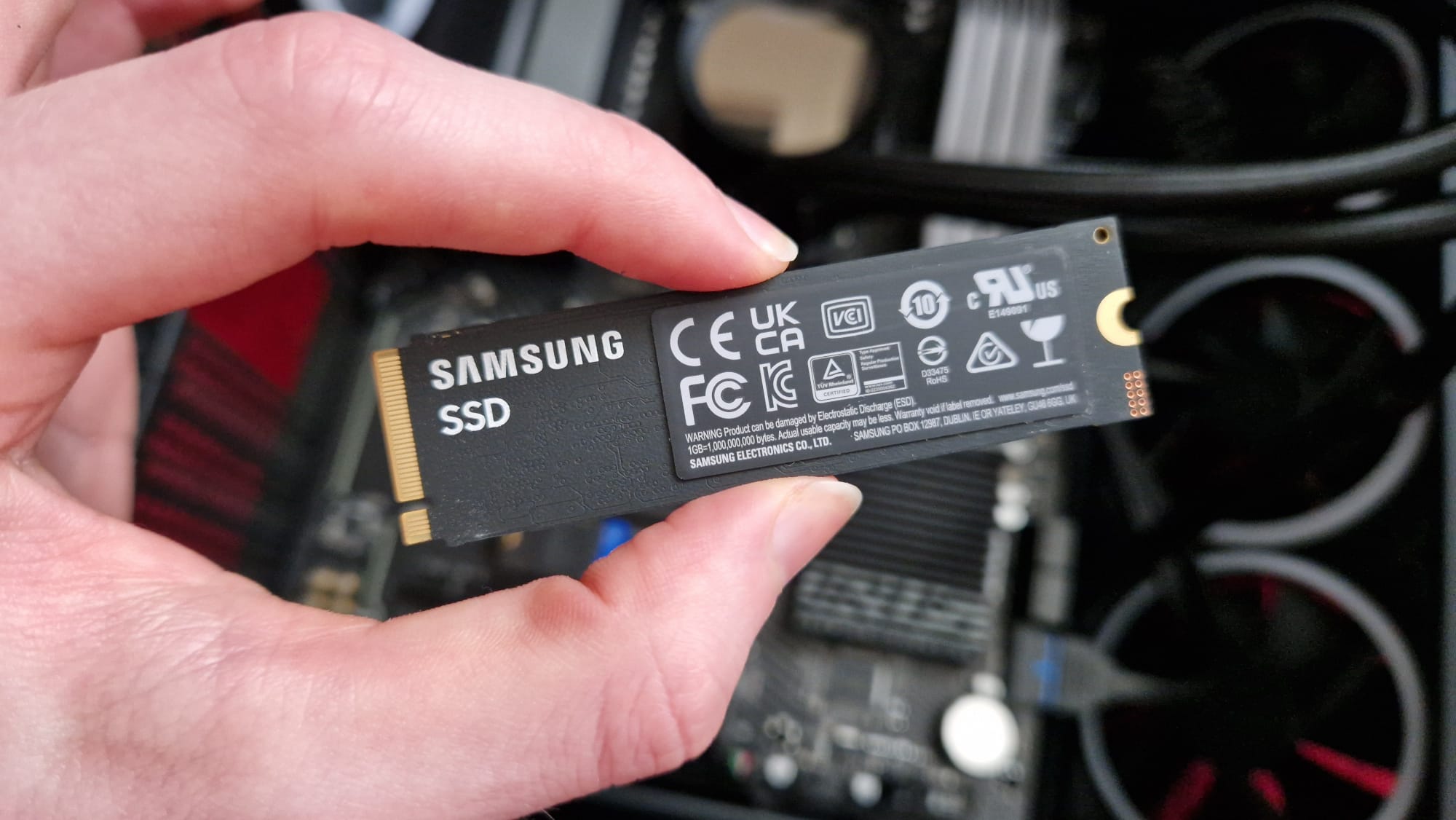
Alongside that 1TB version, the 9100 Pro has 2TB, 4TB, and 8TB capacity options as well. The 8TB model is yet to arrive on the shelves, but the 4TB costs enough to know that the incoming large-capacity one will be a remortgaging job. 4TB in the US will set you back $549 and £409.79 in the UK. I usually say 2TB is a happy medium, but an MSRP of $299.99 / £223.79 makes it the same price as a Meta Quest 3S if you’re stateside. The Samsung 9100 Pro is available with an integrated heatsink as well if you want to show it off in your best gaming PC, but those heatsink models will add even more to the price.
That heatsink is at least designed in a friendly way, with 8.8mmT supposedly doing a more efficient job of preventing overheating while not taking up too much real estate. As someone who has had plenty of trouble trying to fit obnoxious Gen 5 SSD heatsinks into a gaming PC, I can tell you that’s a welcome architectural change, and definitely a benefit of Samsung sitting the first batch of this generation’s drives out.
The 9100 Pro is compatible with gaming PCs and laptops, and it’s nice that this has been thought of, considering most Gen 5 products so far haven’t tried to cater to a more portable market. My colleague Tabitha just reviewed the first gaming laptop with a Gen 5 SSD in it, the MSI Raider A18 HX A9W, so support is definitely on the way for the laptop crowd. The press materials I’m seeing also say the 9100 Pro is compatible with game consoles, but I wouldn’t use this as an SSD for PS5 since it doesn’t have Gen 5 support.
Features

The Samsung 9100 Pro features an on-the-box sequential read speed of 14,800MB/s and a write speed of 13,400MB/s. Compared to the Samsung 990 Pro, which currently holds the gold medal for any Gen 4 drive in terms of speed, that’s a marked 99% claimed increase in performance - essentially doubling the potential speeds you’ll be able to harness. So what is it about the 9100 Pro that allows it to just about break the sound barrier?
Weekly digests, tales from the communities you love, and more
Well, for starters, this drive utilizes the PCIe 5.0 interface, like the Crucial T700 Pro does. Unlike Crucial, there’s not as much sharing of internal controllers with other brands here, since Samsung makes its own. The 9100 Pro uses the homemade Presto controller, which is aptly named. There’s also 8th-generation V-NAND cache tech on board. For those thinking about longevity, the 2TB model has an endurance of 1,200TB, but if that isn’t good enough for you, there’s a 5-year warranty. Going through that amount of space in a 5-year period sounds like a fun challenge, don’t you think?
Despite all of this fancy architecture, the 9100 Pro still fits a regular M.2, 2280 port. But with all of those great claims made, how does the 4TB model perform in real-world tests?
Performance
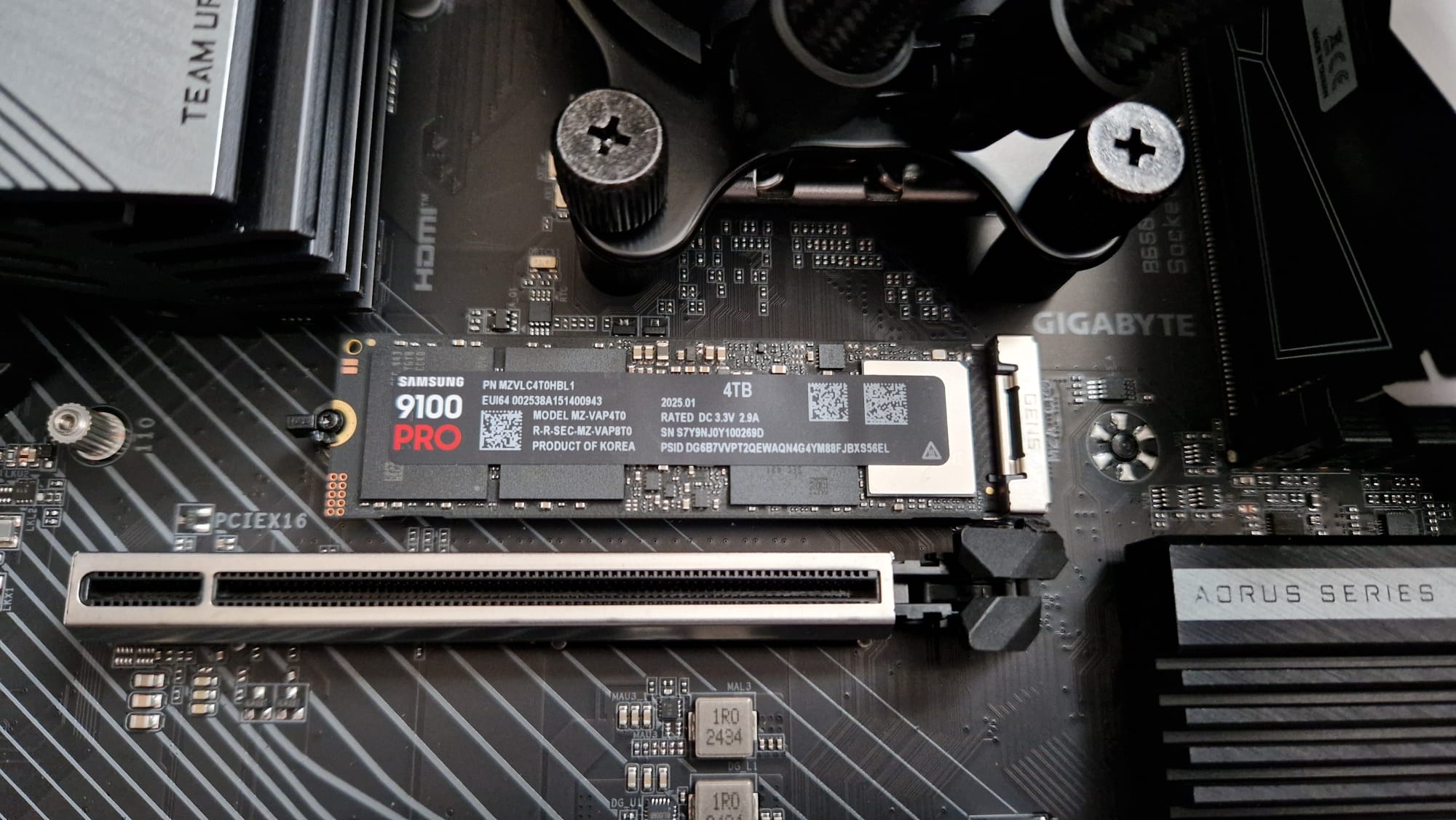
As you might expect, the answer is “fast”. I always start my SSD testing with some sequential read and write benchmarks in CrystalDiskMark, and the Samsung 9100 Pro pulled in even faster numbers than the Crucial T700 Pro. After averaging the results of three tests, the 9100 Pro comes just shy of its on-the-box read speed promises, but it’s still the fastest drive we’ve ever tested by some margin. It does, however, exceed its write speed promises.
| Row 0 - Cell 0 | Read speed (MB/s) | Write speed (MB/s) |
Test 1 | 14,644 | 13,406 |
Test 2 | 14,745 | 13,411 |
Test 3 | 14,744 | 13,401 |
Test 4 | 14,711 | 13,416 |
But how do these synthetic tests equate to practical uses in the real world? With video game support and DirectStorage waning, the best use for these next-gen SSDs at the moment is zipping massive files from one place on your computer to another. I first transferred 77GB of game files and data from one drive to another using Steam and set a stopwatch on how long it took. Moving the game files from Samsung’s slightly older 990 Evo drive to the new 9100 Pro took just 20 seconds, and transferring them back again took a similar 22 seconds. Similarly, in Windows, transferring 107GB of 4K gameplay footage was similarly speedy. Moving from the 990 Evo to the 9100 Pro took 28 seconds, and moving it back took 32 seconds. For a 3-hour-plus chunk of 4K video, that’s a pretty slick transfer, and it gives you a sense of how the 9100 Pro is going to interact with Gen 4 drives you might already own.
Windows DirectStorage was supposed to be a widely adopted feature in a lot of games by this point but, over the last few years, it’s become this obscure, hooded figure lurking in the back corner of the pub.
When Gen 5 drives started appearing, it was clear that there were teething issues. Perhaps the biggest one was thermal control, and Samsung had certainly found the solution before launching its first proper Gen 5 product. I put the 9100 Pro under my motherboard’s regular heatsink, and it did a great job of keeping its temperature control - no massive heatsink needed, no air-cooling system necessary (looking at you, Adata), and no special thermal pad, either. The 9100 Pro had an ambient temperature of just 43 degrees, and it only rose to a 46-degree peak when I was doing all of those file transfer tests. That’s not too dissimilar from the T-Force A440 Lite Gen 4 SSD, which has some of the best thermal performance of any drive we’ve tested lately. Samsung has clearly done work to ensure that its blazing-fast flagship is fully grown into its teeth before launching it to the public.
Then we come to gaming tests. I’ll reiterate once again that the tests I’m about to share with you aren’t perfect measurements by any means. Loading up various games and stopwatching how long they take is an imperfect science, and I accept that, but I do so to give you a broad idea of the types of gaming performance you can expect from a drive like this. For comparison with the previous fastest drive I’ve used, I went back to the Crucial T700 Pro and got some refreshed benchmarks. For comparisons with “slower” Gen 4 options, I also retested the WD Blue SN500 4TB. While I will compare them for the sake of this review, the Crucial and WD Blue SSDs were tested in a different computer, so keep that in mind.
| Row 0 - Cell 0 | Samsung 9100 Pro 4TB | Crucial T700 Pro 2TB | WD Blue SN500 4TB |
Hunt: Showdown 1896 | 22 sec | 27 sec | 27 sec |
Outer Wilds | 3.6 sec | 3.4 sec | 3.8 sec |
Sable | 5.6 sec | 9.4 sec | 9 sec |
Baldur’s Gate 3 | 16 sec | 22 sec | 23 sec |
Planet Zoo | 12 sec | 14 sec | 15 sec |
Across the board, the Samsung 9100 Pro has produced better gaming results than the Crucial T700 Pro, and that’s a welcome surprise. It’s hardly by much, but it’s a noticeable trend in each game (except Outer Wilds, which loads so fast that this could very easily be human error). I’m honestly happy to see these kinds of improvements, even if they’re not exactly going to be noticeable if you’re not sitting with a stopwatch on each loading screen, like me. Baldur’s Gate 3 did net the biggest performance leap on the 9100 Pro, which is nice if you’re a big ol’ save scummer like me.
As you can likely see for yourself, though, the leap from the Gen 4 WD Blue SN500 is a matter of about 5-7 seconds in most titles. If you’re buying to mainly play multiplayer games, like Hunt Showdown, you’re still going to need to wait for the other players loading on older drives before you can start playing anyway, and depending on things like servers, connection speeds, and all the rest of it, that slick loading speed will probably balance out with other players anyway. In jam-packed city builders and management games like Planet Zoo, are you really going to notice a few seconds more when loading in? I doubt it, but you might notice that larger dent in your bank balance after spending big on the 9100 Pro.
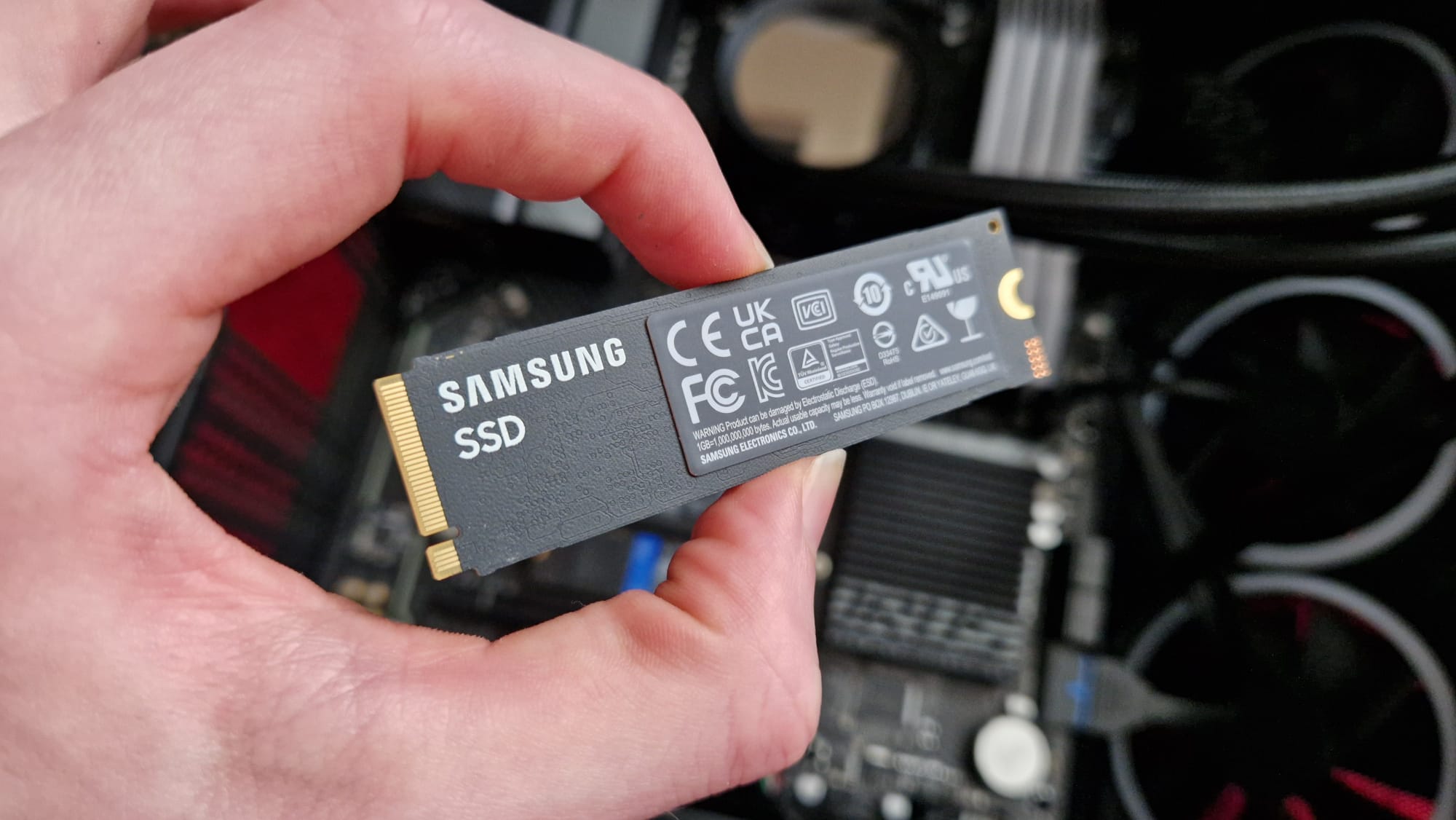
Windows DirectStorage was supposed to be a widely adopted feature in a lot of games by this point but, over the last few years, it’s become this obscure, hooded figure lurking in the back corner of the pub. There are rumours around the game dev patrons that talking to this guy can improve your loading times, but hardly anyone ever does.
DirectStorage essentially allows a Gen 5 SSD to bypass sending information to your CPU, and diverts it right to your GPU, allowing for faster loading and rendering. The problem is, the software is still imperfect and, right now, barely makes a difference - certainly not one that’s worth the inevitable extra coding and busywork it takes to integrate it into in-progress games. The list of supported titles right now is woefully small and, honestly, even if your favorite game is found on it, I wouldn’t say spending the extra money on a Gen 5 drive is going to be worth it.
For this review, I checked DirectStorage games at the door because I wanted to see how the performance of regular titles could be improved through the latest standard of Gen 5 SSD tech. In all honesty, I expected worse results, but the improvements I saw over Crucial’s flagship from just a year or so ago fill me with hope that we are going to see better improvements in loading times as the technology increases in terms of raw performance. That said, loading times are already pretty minuscule, so until a few massive games come along and use this tech to have no loading screens whatsoever, it’s going to be hard to argue these things are worth their additional costs.
Should you buy the Samsung 9100 Pro?
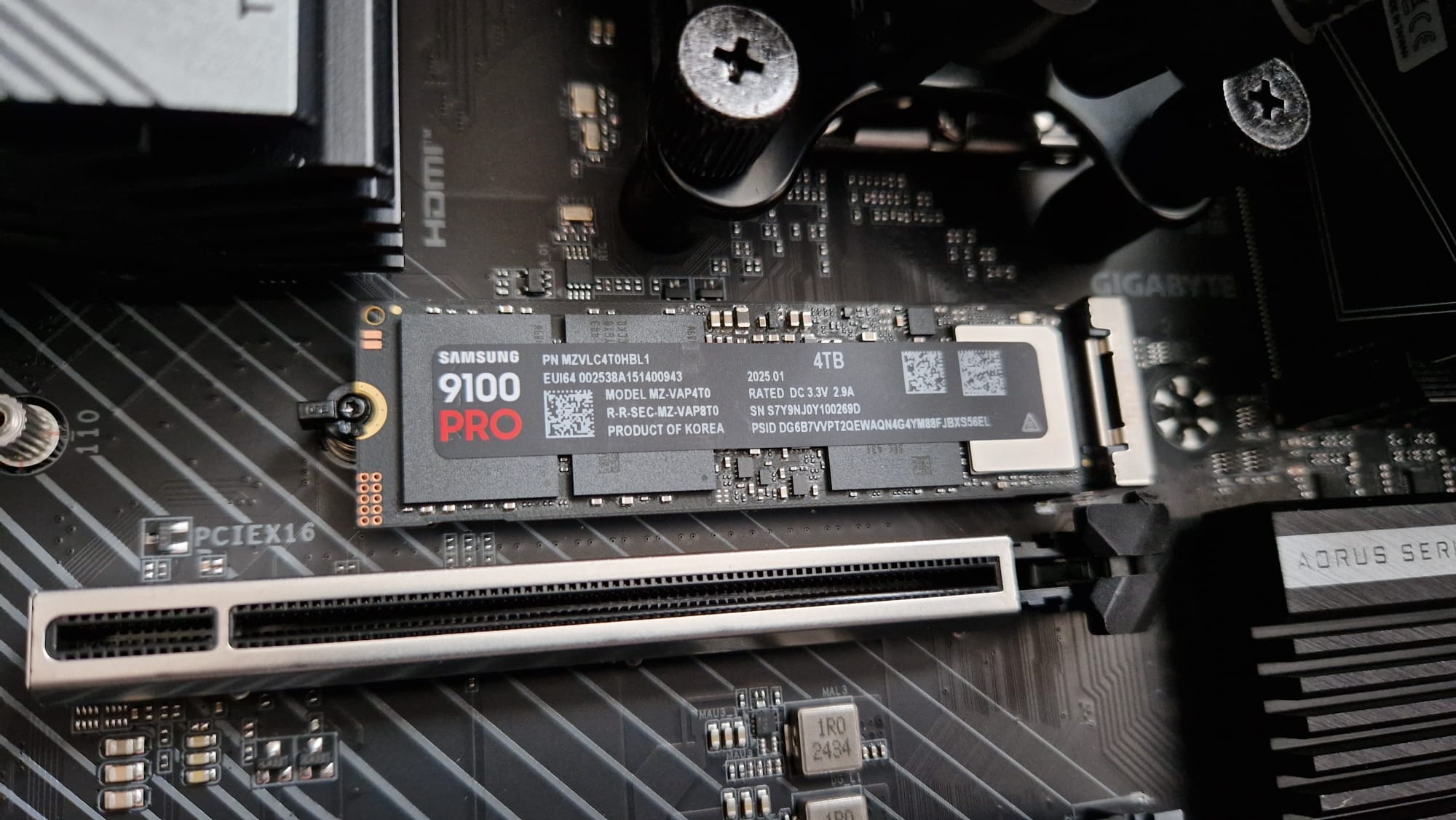
The Samsung 9100 Pro is easily the best SSD I’ve ever tested, and the fastest across the board. It is nothing short of a feat of engineering, but one you probably don’t need, and won’t for quite some time yet.
Yes, if you’re looking to build the most futureproofed gaming PC imaginable, then this, or the brand new WD Black SN1800 (the equivalent from SanDisk), is going to be the drive to pick. If you’re a full-time content creator, video editor, or someone who churns through digital storage with ease, the Samsung 9100 Pro is going to offer you the best performance possible. Having seen some improvements over previous Gen 5 options, I can recommend this as the product to go for if you’re married to the idea of a next-gen device.
If it’s just for gaming, the numbers can’t lie. You are going to get extremely slick loading times across the board with the 9100 Pro. The question you have to answer is whether or not the few seconds' worth of quicker loading times are going to be worth it for you compared to a Gen 4 option that’s potentially hundreds cheaper. Until there’s widely adopted support within every game, I’d still recommend that most gamers stick with Gen 4.
How I tested the Samsung 9100 Pro
I put the Samsung 9100 Pro to work by running it through our usual gauntlet of storage benchmarks. Firstly, I used CrystalDiskMark to give me some synthetic benchmarking scores to broadly test its sequential read and write speeds. After three of these benchmarks at different points of the testing process, I averaged out the results and presented them in a table.
I then used both Steam and Windows 11 to transfer various bits of data from one drive to another, timing how long it took. I kept an eye on temperatures while doing so to assess thermal control.
For gaming, I loaded into various games, some with typically slower loading speeds and some with faster ones. I used a stopwatch to track these loading times, and performed the same tests on two competing drives to come to a verdict on the results, and the Samsung 9100 Pro’s value for money.
For more on how we test, check out the full GamesRadar+ Hardware Policy.
Happy with an external storage device for now? Check out the best external hard drives for gaming, the best PS5 external hard drives, and the best Xbox Series X hard drive.
One of my earliest memories is playing SuperMario64 and wondering why the controller I held had three grips, but I only had two hands. Ever since I've been in love with video games and their technology. After graduating from Edinburgh Napier University with a degree in Journalism, I contributed to the Scottish Games Network and completed an Editorial Internship at Expert Reviews. Over the last decade, I’ve been managing my own YouTube channel about my love of games too. These days, I'm one of the resident hardware nerds at GamesRadar+, and I take the lead on our coverage of gaming PCs, VR, controllers, gaming chairs, and content creation gear. Now, I better stop myself here before I get talking about my favourite games like HUNT: Showdown, Dishonored, and Towerfall Ascension.
You must confirm your public display name before commenting
Please logout and then login again, you will then be prompted to enter your display name.
